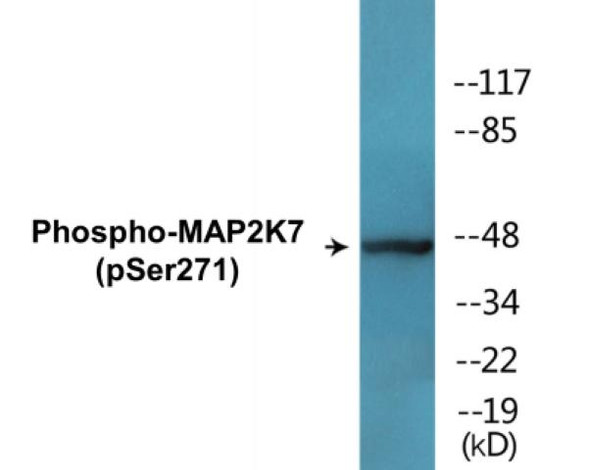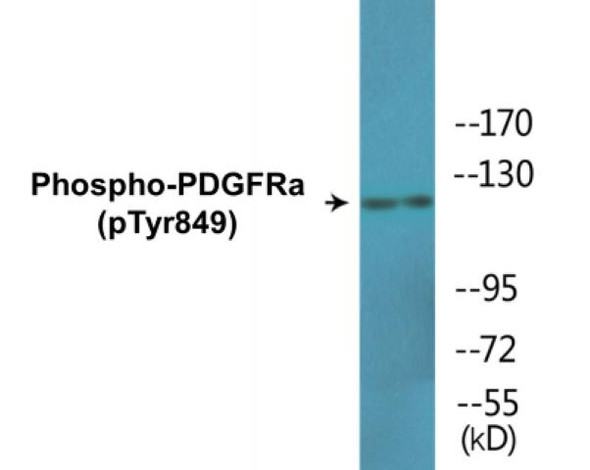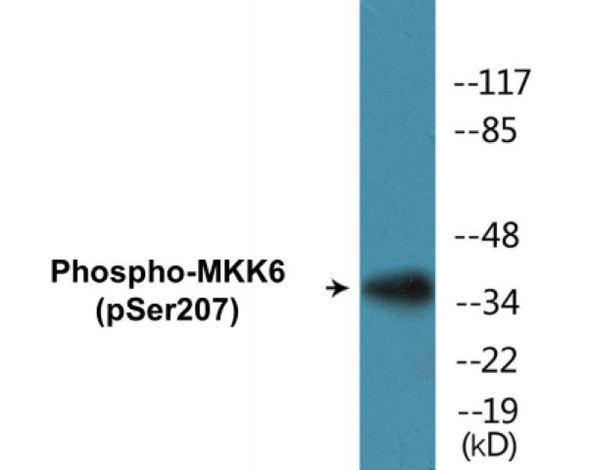ALOX5 (Phospho-Ser271)Colorimetric Cell-Based ELISA Kit (CBCAB01364)
- SKU:
- CBCAB01364
- Product Type:
- ELISA Kit
- ELISA Type:
- Cell Based Phospho Specific
- Research Area:
- Metabolism
- Reactivity:
- Human
- Mouse
- Rat
- Detection Method:
- Colorimetric
Description
ALOX5 (Phospho-Ser271)Colorimetric Cell-Based ELISA Kit
The ALOX5 (Phospho-Ser271) Colorimetric Cell-Based ELISA Kit is a cutting-edge tool designed for the quantitative measurement of ALOX5 phosphorylation at Ser271 in cell lysates. This kit offers exceptional sensitivity and specificity, ensuring accurate and reproducible results for a variety of research applications.ALOX5, also known as 5-lipoxygenase, is a key enzyme involved in the metabolism of arachidonic acid and the production of leukotrienes, which play crucial roles in inflammation and immune response.
Phosphorylation at Ser271 is known to regulate ALOX5 activity and is implicated in various inflammatory disorders, making it a valuable target for research and drug development.With this advanced kit, researchers can uncover new insights into the regulation of ALOX5 signaling pathways and explore novel therapeutic strategies for inflammatory diseases. Trust the ALOX5 (Phospho-Ser271) Colorimetric Cell-Based ELISA Kit for accurate and reliable data to drive your research forward.
| Product Name: | ALOX5 (Phospho-Ser271)Colorimetric Cell-Based ELISA Kit |
| Product Code: | CBCAB01364 |
| ELISA Type: | Cell-Based |
| Target: | ALOX5 (Phospho-Ser271) |
| Reactivity: | Human, Mouse, Rat |
| Dynamic Range: | > 5000 Cells |
| Detection Method: | Colorimetric 450 nm |
| Format: | 2 x 96-Well Microplates |
The ALOX5 (Phospho-Ser271) Colorimetric Cell-Based ELISA Kit is a convenient, lysate-free, high throughput and sensitive assay kit that can detect ALOX5 protein phosphorylation and expression profile in cells. The kit can be used for measuring the relative amounts of phosphorylated ALOX5 in cultured cells as well as screening for the effects that various treatments, inhibitors (ie. siRNA or chemicals), or activators have on ALOX5 phosphorylation.
Qualitative determination of ALOX5 (Phospho-Ser271) concentration is achieved by an indirect ELISA format. In essence, ALOX5 (Phospho-Ser271) is captured by ALOX5 (Phospho-Ser271)-specific primary (1ø) antibodies while the HRP-conjugated secondary (2ø) antibodies bind the Fc region of the 1ø antibody. Through this binding, the HRP enzyme conjugated to the 2ø antibody can catalyze a colorimetric reaction upon substrate addition. Due to the qualitative nature of the Cell-Based ELISA, multiple normalization methods are needed:
| 1. | A monoclonal antibody specific for human GAPDH is included to serve as an internal positive control in normalizing the target absorbance values. |
| 2. | Following the colorimetric measurement of HRP activity via substrate addition, the Crystal Violet whole-cell staining method may be used to determine cell density. After staining, the results can be analysed by normalizing the absorbance values to cell amounts, by which the plating difference can be adjusted. |
| Database Information: | Gene ID: 240, UniProt ID: P09917, OMIM: 152390, Unigene: Hs.89499 |
| Gene Symbol: | ALOX5 |
| Sub Type: | Phospho |
| UniProt Protein Function: | 5-LO: arachidonate 5-lipoxygenase. Arachidonic acid promotes its phosphorylation by p38 MAPK-regulated MAPKAP kinases. Upregulated in glioblastoma multiforme and colon, pancreatic and bladder cancer. |
| UniProt Protein Details: | Protein type:Lipid Metabolism - linoleic acid; Nuclear envelope; EC 1.13.11.34; Oxidoreductase; Lipid Metabolism - arachidonic acid Chromosomal Location of Human Ortholog: 10q11.2 Cellular Component: extracellular space; nuclear membrane; nuclear matrix; nuclear envelope lumen; nuclear envelope; cytosol Molecular Function:protein binding; iron ion binding; arachidonate 5-lipoxygenase activity Biological Process: leukotriene biosynthetic process; leukotriene production during acute inflammatory response; lipoxygenase pathway; arachidonic acid metabolic process; leukotriene metabolic process Disease: Asthma, Susceptibility To |
| NCBI Summary: | This gene encodes a member of the lipoxygenase gene family and plays a dual role in the synthesis of leukotrienes from arachidonic acid. The encoded protein, which is expressed specifically in bone marrow-derived cells, catalyzes the conversion of arachidonic acid to 5(S)-hydroperoxy-6-trans-8,11,14-cis-eicosatetraenoic acid, and further to the allylic epoxide 5(S)-trans-7,9-trans-11,14-cis-eicosatetrenoic acid (leukotriene A4). Leukotrienes are important mediators of a number of inflammatory and allergic conditions. Mutations in the promoter region of this gene lead to a diminished response to antileukotriene drugs used in the treatment of asthma and may also be associated with atherosclerosis and several cancers. Alternatively spliced transcript variants encoding different isoforms have been found for this gene. [provided by RefSeq, Jan 2012] |
| UniProt Code: | P09917 |
| NCBI GenInfo Identifier: | 126407 |
| NCBI Gene ID: | 240 |
| NCBI Accession: | P09917.2 |
| UniProt Secondary Accession: | P09917,Q5JQ14, B7ZLS0, E5FPY5, E5FPY7, E5FPY8, |
| UniProt Related Accession: | P09917 |
| Molecular Weight: | 674 |
| NCBI Full Name: | Arachidonate 5-lipoxygenase |
| NCBI Synonym Full Names: | arachidonate 5-lipoxygenase |
| NCBI Official Symbol: | ALOX5 |
| NCBI Official Synonym Symbols: | 5-LO; 5LPG; LOG5; 5-LOX |
| NCBI Protein Information: | arachidonate 5-lipoxygenase; LOX-5; leukotriene A4 synthase; arachidonic acid 5-lipoxygenase; arachidonic 5-lipoxygenase alpha-10 isoform; arachidonic 5-lipoxygenase delta-13 isoform; arachidonic 5-lipoxygenase delta-p10 isoform; arachidonic 5-lipoxygenase delta-10-13 isoform |
| UniProt Protein Name: | Arachidonate 5-lipoxygenase |
| Protein Family: | Arachidonate 5-lipoxygenase |
| UniProt Gene Name: | ALOX5 |
| UniProt Entry Name: | LOX5_HUMAN |
| Component | Quantity |
| 96-Well Cell Culture Clear-Bottom Microplate | 2 plates |
| 10X TBS | 24 mL |
| Quenching Buffer | 24 mL |
| Blocking Buffer | 50 mL |
| 15X Wash Buffer | 50 mL |
| Primary Antibody Diluent | 12 mL |
| 100x Anti-Phospho Target Antibody | 60 µL |
| 100x Anti-Target Antibody | 60 µL |
| Anti-GAPDH Antibody | 60 µL |
| HRP-Conjugated Anti-Rabbit IgG Antibody | 12 mL |
| HRP-Conjugated Anti-Mouse IgG Antibody | 12 mL |
| SDS Solution | 12 mL |
| Stop Solution | 24 mL |
| Ready-to-Use Substrate | 12 mL |
| Crystal Violet Solution | 12 mL |
| Adhesive Plate Seals | 2 seals |
The following materials and/or equipment are NOT provided in this kit but are necessary to successfully conduct the experiment:
- Microplate reader able to measure absorbance at 450 nm and/or 595 nm for Crystal Violet Cell Staining (Optional)
- Micropipettes with capability of measuring volumes ranging from 1 µL to 1 ml
- 37% formaldehyde (Sigma Cat# F-8775) or formaldehyde from other sources
- Squirt bottle, manifold dispenser, multichannel pipette reservoir or automated microplate washer
- Graph paper or computer software capable of generating or displaying logarithmic functions
- Absorbent papers or vacuum aspirator
- Test tubes or microfuge tubes capable of storing ≥1 ml
- Poly-L-Lysine (Sigma Cat# P4832 for suspension cells)
- Orbital shaker (optional)
- Deionized or sterile water
*Note: Protocols are specific to each batch/lot. For the correct instructions please follow the protocol included in your kit.
| Step | Procedure |
| 1. | Seed 200 µL of 20,000 adherent cells in culture medium in each well of a 96-well plate. The plates included in the kit are sterile and treated for cell culture. For suspension cells and loosely attached cells, coat the plates with 100 µL of 10 µg/ml Poly-L-Lysine (not included) to each well of a 96-well plate for 30 minutes at 37 °C prior to adding cells. |
| 2. | Incubate the cells for overnight at 37 °C, 5% CO2. |
| 3. | Treat the cells as desired. |
| 4. | Remove the cell culture medium and rinse with 200 µL of 1x TBS, twice. |
| 5. | Fix the cells by incubating with 100 µL of Fixing Solution for 20 minutes at room temperature. The 4% formaldehyde is used for adherent cells and 8% formaldehyde is used for suspension cells and loosely attached cells. |
| 6. | Remove the Fixing Solution and wash the plate 3 times with 200 µL 1x Wash Buffer for five minutes each time with gentle shaking on the orbital shaker. The plate can be stored at 4 °C for a week. |
| 7. | Add 100 µL of Quenching Buffer and incubate for 20 minutes at room temperature. |
| 8. | Wash the plate 3 times with 1x Wash Buffer for 5 minutes each time. |
| 9. | Add 200 µL of Blocking Buffer and incubate for 1 hour at room temperature. |
| 10. | Wash 3 times with 200 µL of 1x Wash Buffer for 5 minutes each time. |
| 11. | Add 50 µL of 1x primary antibodies Anti-ALOX5 (Phospho-Ser271) Antibody, Anti-ALOX5 Antibody and/or Anti-GAPDH Antibody) to the corresponding wells, cover with Parafilm and incubate for 16 hours (overnight) at 4 °C. If the target expression is known to be high, incubate for 2 hours at room temperature. |
| 12. | Wash 3 times with 200 µL of 1x Wash Buffer for 5 minutes each time. |
| 13. | Add 50 µL of 1x secondary antibodies (HRP-Conjugated AntiRabbit IgG Antibody or HRP-Conjugated Anti-Mouse IgG Antibody) to corresponding wells and incubate for 1.5 hours at room temperature. |
| 14. | Wash 3 times with 200 µL of 1x Wash Buffer for 5 minutes each time. |
| 15. | Add 50 µL of Ready-to-Use Substrate to each well and incubate for 30 minutes at room temperature in the dark. |
| 16. | Add 50 µL of Stop Solution to each well and read OD at 450 nm immediately using the microplate reader. |
(Additional Crystal Violet staining may be performed if desired – details of this may be found in the kit technical manual.)






